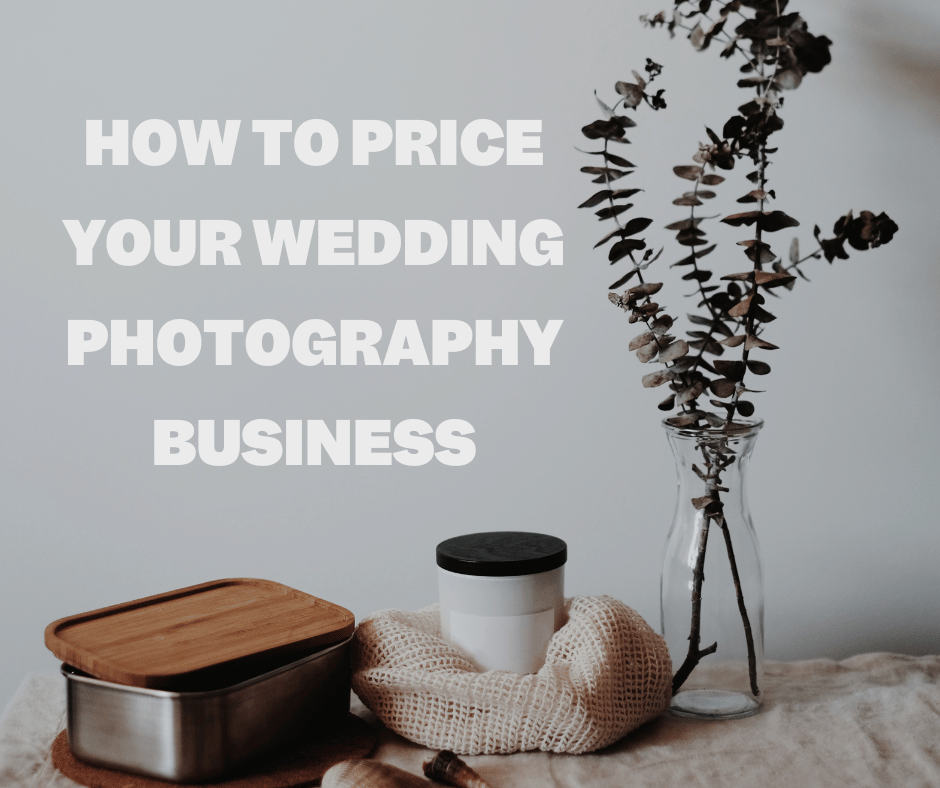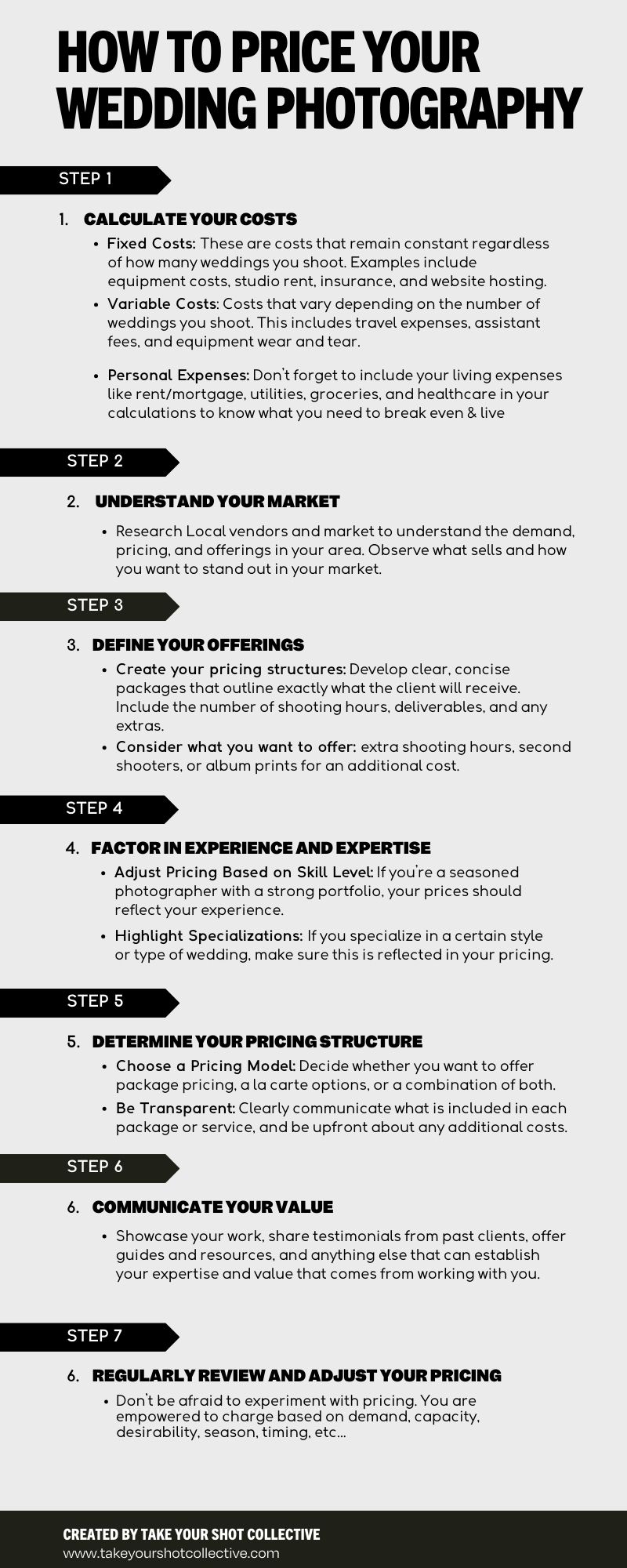Understanding your Costs as a Wedding Photographer before setting your price
When it comes to knowing how to price your wedding photography business, one of the most critical steps is understanding and accurately calculating your costs. This lays the foundation for setting prices that not only cover your expenses but also ensure you are compensated fairly for your time, skill, and expertise. In this section, we will delve into the key components of your costs, helping you to build a comprehensive view of your financial landscape.

Wedding Photography Cost of Doing Business (CDB)
The Cost of Doing Business is essentially the total of all the expenses associated with running your photography business. These expenses can be broadly categorized into various areas, each contributing to your ability to operate and deliver exceptional service to your clients.
- Equipment Costs: This includes cameras, lenses, lighting, memory cards, and other photography gear. Remember to account for maintenance, repairs, and eventual replacements.
- Travel and Transportation: Whether you’re driving to a nearby venue or flying to a destination wedding, travel costs can add up quickly. Include fuel, flights, accommodation, and any other travel-related expenses.
- Insurance and Permits: Protecting your business and equipment is non-negotiable. Calculate the cost of business insurance, equipment insurance, and any permits you need to operate legally.
- Marketing and Advertising: From your website to social media advertising, getting the word out about your business is crucial. Allocate a budget for marketing and promotional activities.
- Legal and Administrative Costs: This covers everything from contract development with a lawyer to accounting and bookkeeping services.
- Studio and Office Space: If you rent a studio or office space, include this in your CDB. Don’t forget utilities and any other associated costs.
- Education and Professional Development: Investing in workshops, courses, and books to improve your skills is essential for staying competitive.
- Subscriptions and Services: This includes software for photo editing, client management tools, website hosting, and any other services you subscribe to.
- Personnel Costs: If you have assistants, second shooters, or other staff, include their wages and any associated costs.
- Product Costs: This includes albums, prints, and any other products you provide to your clients.
- Miscellaneous Costs: Finally, have a category for any other miscellaneous costs that don’t fit elsewhere.
To calculate your CDB per wedding, add up all these expenses to find your total annual business expenses. Then, divide this number by the estimated number of weddings you plan to shoot in a year. This gives you a clear picture of what it costs to operate your business per wedding, ensuring you’re not undercharging and putting your business at risk.
Personal Living Expenses
As a self-employed wedding photographer, the line between personal and business finances can often blur. It’s vital to ensure that your business income can support your personal living expenses. This includes your rent or mortgage, utilities, groceries, healthcare, and any other regular bills. Additionally, consider lifestyle choices and discretionary spending to have a holistic understanding of your financial needs.
Debts and Savings
In managing your finances, it’s crucial not to overlook debts and savings. If you have existing debts, whether personal or business-related, create a repayment plan and factor these payments into your financial calculations. On the flip side, building savings is essential for financial security and future investments. This includes an emergency fund for unforeseen expenses, retirement savings, and potentially a fund for future business expansion or equipment upgrades. Ensuring your business income can cover these areas is critical for long-term stability and growth.
Financial Goals
Lastly, setting clear financial goals gives you direction and purpose in your business. These goals can be short-term, such as upgrading your camera gear in the next year, or long-term, like expanding your team or opening a studio. Your pricing should be structured in a way that moves you closer to achieving these goals, providing a roadmap for your business’s financial journey.
Understanding your costs is a foundational aspect of pricing your wedding photography business. It requires a comprehensive approach, taking into account both the direct costs of running your business and your personal financial needs and goals. With this knowledge, you can create a pricing strategy that ensures the sustainability and growth of your business, allowing you to continue doing what you love.

Pricing Models for Wedding Photography
The way you choose to price your wedding photography services is a critical decision that impacts how potential clients perceive your business and ultimately affects your bottom line. In this section, we will explore various pricing models that are prevalent in the wedding photography industry, each with its unique advantages and considerations. By understanding these models, you can make an informed decision on which approach aligns best with your business goals and customer base.
Wedding Package Pricing
Package pricing is a popular and straightforward approach many wedding photographers adopt. In this model, you create pre-designed packages that outline exactly what the client will receive for a set price. This could include a specific number of hours of coverage, a certain number of edited photos, an album, and possibly additional services like an engagement shoot.
Clients appreciate package pricing for its simplicity and clarity. They know upfront what they are getting and at what cost. From a business perspective, this model allows for efficient workflow management as you have predefined offerings. However, it is crucial to carefully construct your packages to ensure they are profitable and cater to the diverse needs of your clients.
A La Carte Pricing for wedding photography
A La Carte pricing offers more flexibility and customization for both the photographer and the client. In this model, you provide a base rate for your essential services and allow clients to add additional services or products as needed. This could include extra hours of coverage, a second shooter, additional edits, or physical products like prints and albums.
This model is excellent for catering to a wide range of budgets and preferences, allowing clients to tailor your services to their specific needs. However, it requires clear communication and transparent pricing to avoid any potential confusion or miscommunication.
Hourly Photography Rate
Charging an hourly rate is a straightforward approach where you set a fixed rate for each hour you spend shooting. This model is transparent and provides a clear correlation between time spent and compensation received. However, it’s essential to ensure that your hourly rate not only covers the time spent shooting but also the considerable time spent in post-processing, client communication, and other non-shooting related activities.
Wedding Day Rate
The day rate model involves charging a set fee for a full day of shooting, regardless of the exact number of hours worked. This is a common approach in event and corporate photography but can also be applied to weddings, particularly for longer events. The day rate should reflect the value of your entire day’s commitment and the potential opportunity cost of not being available for other bookings.
Customized photography Quotes
Lastly, the customized quote model involves creating tailored quotes for each client based on their specific needs, the desirability of the event, your availability, and other factors. This approach allows for maximum flexibility and the potential to maximize your earnings, particularly for high-demand dates or unique, high-profile events. However, it requires a thorough understanding of your costs and value to ensure profitability and consistency in your pricing.
Each of these pricing models has its unique strengths and considerations, and the best choice depends on your business structure, target market, and personal preferences. What’s most important is that your chosen model reflects the value you provide, covers your costs, and helps you achieve your financial goals. Transparent communication, consistency in pricing, and a deep understanding of your market are key to successfully implementing any pricing strategy.

Factors Influencing Your Wedding Photograph Pricing
Establishing a pricing strategy for your wedding photography business is a complex task, influenced by various external and internal factors. In this section, we will discuss key elements that play a significant role in determining how you should price your services. By understanding and considering these factors, you can ensure your pricing accurately reflects your value, experience, and the unique aspects of your business.
Photography Experience and Skill Level
One of the most direct influences on your pricing is your experience and skill level as a photographer. Newer photographers, or those just starting in the wedding industry, often price their services lower as they work to build their portfolio and gain experience. As you grow in your career, honing your skills and developing a strong portfolio, your prices should increase to reflect your enhanced expertise and reliability. Clients are paying not just for your time, but for your experience, artistic vision, and ability to consistently deliver high-quality results.
Market Demand and Location
The demand for wedding photography services in your specific market, as well as the location of your business, also significantly impact your pricing strategy. If you are in a high-demand area with a large number of weddings and affluent clients, there may be an opportunity to price your services higher. Conversely, in less affluent areas or markets with lower demand, you may need to adjust your prices to remain competitive.
Researching your local market is crucial to understanding the average pricing of wedding photography services and how you should position yourself. Consider the demographic of your target clientele, the level of competition, and the average income level in your area. Understanding these aspects of your market will help you set prices that are competitive yet fair, ensuring you attract the right clients for your business.
Season and Timing for wedding photography
The wedding industry is notoriously seasonal, with certain times of the year seeing a higher volume of weddings. During peak wedding seasons, you may be able to command higher prices due to the increased demand for your services. Additionally, consider how last-minute bookings may influence your pricing. Due to the short turnaround time and potential opportunity cost of taking on a last-minute event, you might choose to charge a premium for these bookings.
Photography Specialization and Style
Lastly, your specialization and unique style as a wedding photographer can also justify higher prices. If you have carved out a niche for yourself, catering to a specific style of wedding photography or a particular demographic, this specialization can be a strong selling point. Clients seeking your unique style or expertise may be willing to pay a premium for your services.
Your specialization could be in terms of the photography style (e.g., documentary, fine art, traditional), the type of weddings you shoot (e.g., destination weddings, elopements, cultural weddings), or any other unique aspect that sets you apart from other photographers in your market. Ensure that your branding and marketing clearly communicate your specialization and the value you provide, helping to justify your pricing and attract your ideal clients.
In summary, various factors influence your pricing strategy as a wedding photographer. Your experience and skill level, market demand and location, season and timing of bookings, and any specialization or unique style all play a critical role in determining how you should price your services. By carefully considering these factors and conducting thorough market research, you can establish a pricing strategy that accurately reflects your value, attracts your ideal clients, and contributes to the long-term success of your business.
Communicating Your Value for wedding photography
Successfully pricing your wedding photography business is only part of the equation. Equally important is effectively communicating the value behind your prices to potential clients. In this section, we’ll explore strategies to transparently convey what clients are investing in and educate them on the intricacies of wedding photography. This approach not only builds trust but also fosters an appreciation for your craft, helping to justify your pricing.
Transparency and Clarity around pricing
Clear and transparent communication is key in building a strong relationship with your clients. When discussing your pricing, ensure that you are clear about what is included in each package or service offering. Break down the elements that contribute to the cost, such as the number of shooting hours, the post-processing work, any physical products included, and other relevant details.
Equally important is being upfront about any additional costs that might arise, such as travel fees, extra hours of coverage, or charges for additional edits. By clearly outlining these potential costs from the outset, you mitigate the risk of any misunderstandings or disagreements down the line.
Transparency in your pricing builds trust with potential clients. It demonstrates your integrity as a business owner and helps clients feel more confident in their decision to invest in your services.
Educating clients about photography pricing
Another crucial aspect of communicating your value is educating your clients on what wedding photography entails. Many clients may not be aware of the extensive time and effort that goes into creating stunning wedding images, from the pre-wedding consultations and the hours spent shooting on the wedding day, to the post-processing work and album creation.
Take the time to walk them through your process, highlighting the skill, expertise, and creativity involved at each stage. Share behind-the-scenes glimpses of your workflow, and consider creating educational content that delves into the various aspects of wedding photography. This could be in the form of blog posts, social media content, or even direct communication during consultations.
Educating your clients helps to justify your pricing by showcasing the value and expertise you bring to the table. It sets clear expectations and helps clients understand that they are investing not just in the final product, but in your vision, experience, and the personalized service you provide.
In conclusion, effectively communicating your value is a critical component of your pricing strategy. Transparency in your pricing and educating your clients on the intricacies of your craft helps to build trust, justify your prices, and ensure that clients appreciate the unique value you bring to their wedding experience. By mastering this aspect of client communication, you position yourself to attract clients who respect your work and are willing to invest in the quality and expertise you provide.
More Photography Business Resources:
Join the Free Take Your Shot Online Community!
Free Brand Audit Workbook for wedding photographers
